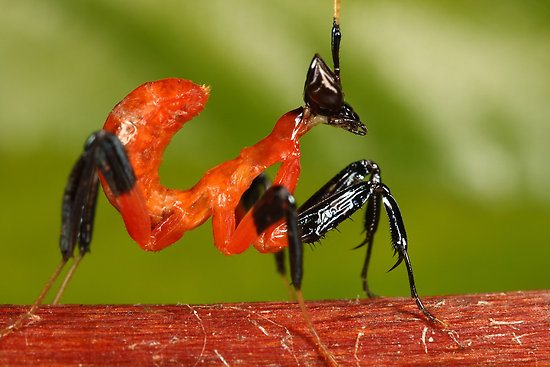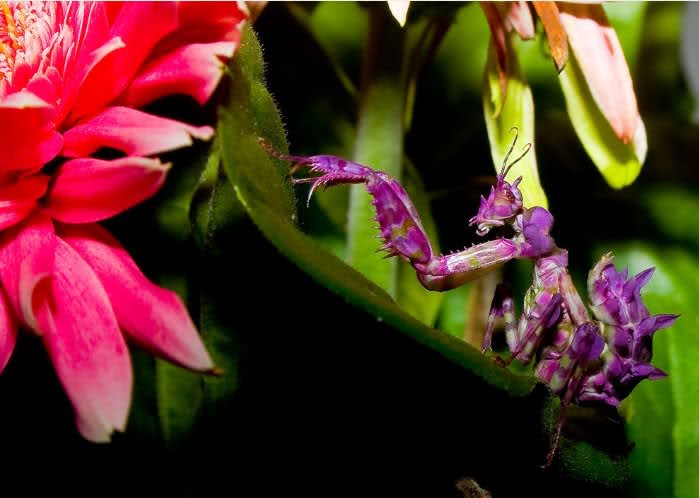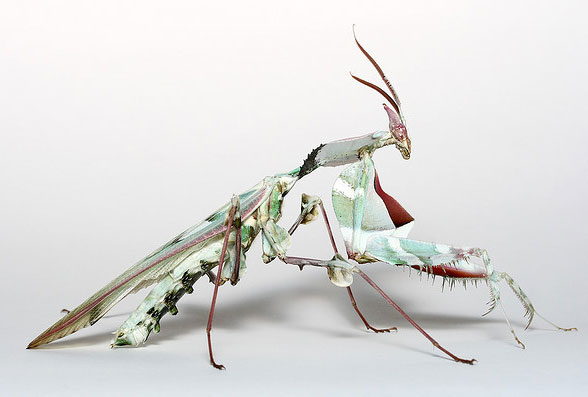It looks like you're using an Ad Blocker.
Please white-list or disable AboveTopSecret.com in your ad-blocking tool.
Thank you.
Some features of ATS will be disabled while you continue to use an ad-blocker.
12
share:
LYING LIKE AN ORCHID An orchid mantis (top) catches insects that come too close, tricked by the insect’s flowerlike appearance. Close-up views of another orchid mantis (bottom) show it feeding on prey.
Orchid mantises have evolved into a fake flower that out-flowers the real thing. The insects don’t seem to be mimicking any real flower found so far, but have invented something even fancier. Among the many oddly shaped mantises of the world, only the petal-legged, corsage-worthy orchid mantis (Hymenopus coronatus) comes close to counterfeiting a whole blossom, says James O’Hanlon of Macquarie University in Sydney. Which can be a nuisance. Searching rainforests for orchid mantises to study is “very frustrating,” O’Hanlon says. “Every time you see a flower you go nuts thinking you’ve found one, and then it’s just a flower.” This resemblance led Alfred Russel Wallace, the largely forgotten also-ran of evolutionary theory, to propose that the phony flowers lure a pollinator close enough to grab in an eye-blink strike. (They can rip apart a butterfly thrice their size.)
Read more HERE
Another fascinating adaptation in the animal kingdom to facilitate its success. I can imagine it would be very hard to find one of these mantises they make Waldo look like a rank amateur.
reply to post by Grimpachi
Nice video! S&F. This is what the first instar of the Orchid mantis looks like:

From Wikipedia:
another flower mantis

and the Devil's Flower mantis

Nice video! S&F. This is what the first instar of the Orchid mantis looks like:

From Wikipedia:
An instar (from the Latin "form", "likeness") is a developmental stage of arthropods, such as insects, between each molt (ecdysis), until sexual maturity is reached.[1] Arthropods must shed the exoskeleton in order to grow or assume a new form. Differences between instars can often be seen in altered body proportions, colors, patterns, or changes in the number of body segments. Some arthropods can continue to molt after sexual maturity, but these subsequent molts are generally not called instars.
another flower mantis

and the Devil's Flower mantis

new topics
-
Are you ready for the return of Jesus Christ? Have you been cleansed by His blood?
Religion, Faith, And Theology: 29 minutes ago -
Chronological time line of open source information
History: 1 hours ago -
A man of the people
Diseases and Pandemics: 3 hours ago -
Ramblings on DNA, blood, and Spirit.
Philosophy and Metaphysics: 3 hours ago -
4 plans of US elites to defeat Russia
New World Order: 4 hours ago -
Thousands Of Young Ukrainian Men Trying To Flee The Country To Avoid Conscription And The War
Other Current Events: 8 hours ago -
12 jurors selected in Trump criminal trial
US Political Madness: 11 hours ago -
Iran launches Retalliation Strike 4.18.24
World War Three: 11 hours ago -
Israeli Missile Strikes in Iran, Explosions in Syria + Iraq
World War Three: 11 hours ago
top topics
-
George Knapp AMA on DI
Area 51 and other Facilities: 17 hours ago, 26 flags -
Israeli Missile Strikes in Iran, Explosions in Syria + Iraq
World War Three: 11 hours ago, 17 flags -
Thousands Of Young Ukrainian Men Trying To Flee The Country To Avoid Conscription And The War
Other Current Events: 8 hours ago, 6 flags -
Iran launches Retalliation Strike 4.18.24
World War Three: 11 hours ago, 6 flags -
Not Aliens but a Nazi Occult Inspired and then Science Rendered Design.
Aliens and UFOs: 17 hours ago, 5 flags -
12 jurors selected in Trump criminal trial
US Political Madness: 11 hours ago, 4 flags -
4 plans of US elites to defeat Russia
New World Order: 4 hours ago, 2 flags -
A man of the people
Diseases and Pandemics: 3 hours ago, 2 flags -
Chronological time line of open source information
History: 1 hours ago, 2 flags -
Ramblings on DNA, blood, and Spirit.
Philosophy and Metaphysics: 3 hours ago, 1 flags
12

